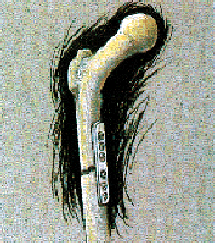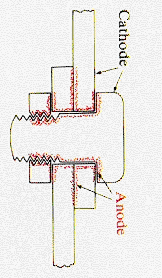|
·
Bone-plates
are devices for strengthening a fractured bone during the healing process.
The device is attached to the bone with metal screws, and is normally removed
once satisfactory healing has occurred.
· In
general, the relatively short period of use minimizes the importance of
corrosion to the mechanical properties of the device. As suggested in the
lower diagram, crevice corrosion in which the anodic regions are less exposed
to the body fluids would contribute to mass loss.
· Stainless
steel alloy containing 18% Cr and 8% Ni and a small percentage of Mo (Type
316) was an early choice. This alloy showed little corrosion on removal.
· If
the steel has chromium carbide (Cr6C23)
deposited in grain-boundary regions, this will deplete the adjacent material
of chromium and give rise to electrolytic grain boundary corrosion.
·
Care
must also be taken that the materials used for the screws and the plates
have the same composition and microstructure. Composition differences will
give rise to galvanic cells and increased corrosion rates. Toxic reactions
can then arise. |
|
|
|
|
|
|
|
|
|
|
|

